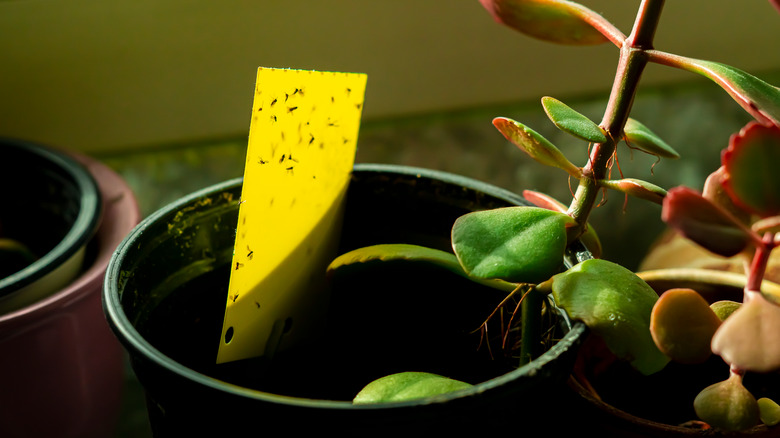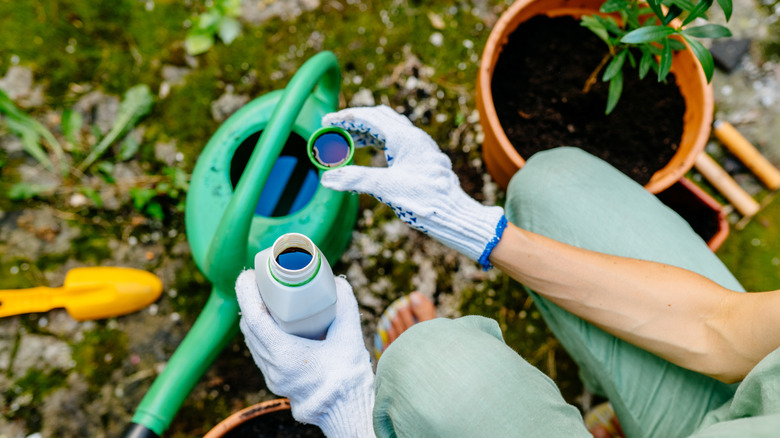Rid Your Houseplants Of Fungus Gnats With A Common Bathroom Staple
If you love the serenity that plants bring to a living space, dealing with pests like fungus gnats can be a real dampener. These tiny creatures may initially seem harmless. However, they're more than capable of causing harm to your beloved greenery, especially in their larval stage. You might come across various treatments and remedies in your quest to protect your plants from gnats. In this myriad of possible solutions, hydrogen peroxide emerges as a champion in this scenario. It's not just your typical first-aid disinfectant; it's a godsend for all those dedicated to preserving their green oasis. Its uniqueness lies in its environmentally-friendly properties combined with its effectiveness. When introduced to the soil, it performs a dual role — targeting and decimating gnat larvae while simultaneously aerating the soil with a burst of oxygen. This isn't merely about extermination; it's rejuvenation. Your plants get a refreshing boost, leading to more robust health and growth.
With this looming threat to your verdant sanctuary, equipping yourself with the right knowledge and tools is paramount. As you embark on this mission to safeguard your plants, let this comprehensive guide be your beacon, shining a light on the most effective methods to ensure a thriving, gnat-free garden.
Understanding the hydrogen peroxide solution
Adding hydrogen peroxide to plants breaks down and releases oxygen, making it an excellent agent against fungus gnat larvae. As you might have noticed, these larvae thrive in the damp, low-oxygen environments of overwatered plant soil. To begin your fight against these pests, prepare a hydrogen peroxide solution. Ideally, you want one part of 3% concentration of hydrogen peroxide mixed with four parts water. Then, generously pour your prepared solution onto the soil. It penetrates the soil and kills the fungus gnat larvae on contact. You'll see a fizzing action as you pour; this is the hydrogen peroxide releasing oxygen.
Yet, your task doesn't end there. After your initial soil treatment, if you notice adult gnats buzzing around, they too require your attention. If left unchecked, these adults can lay a new generation of eggs, undoing all your hard work. To preemptively strike against them, whip up another batch of the solution, this time with the intent of using it as a spray. Combine three parts of water with one part 3% hydrogen peroxide in a spray bottle. Gently mist the plant's leaves, being thorough in your application. This procedure deters the adult gnats and creates an inhospitable environment for any potential offspring. It's crucial to remain vigilant and continue this treatment routine until you're certain that the airspace around your plants is free of these winged invaders.
Post-treatment care and preventative measures
Having treated your plants with hydrogen peroxide, the next phase is ensuring they remain free from future invasions. The hydrogen peroxide treatment, while effective, offers only temporary relief if the conditions favorable to gnats persist. Regular monitoring is key. Periodically inspect the soil around your plants, keeping an eye out for signs of new infestations. Adult gnats might have a fleeting life, but they're prolific breeders, making early detection essential. Plant watering practices play a significant role in fungus gnat infestations. Overly moist conditions are a haven for these pests. Before reaching for the water, assess the moisture level of your plant's soil. Letting the soil dry between waterings can be beneficial for many indoor plants.
As an additional protective measure, you can consider adding a protective layer on top of your plant's soil. Materials like sand or diatomaceous earth act as barriers, discouraging adult gnats from laying their eggs. Another important step is to place your compost bin and any organic waste far from your potted plants. This strategic positioning is vital because it reduces the risk of pests, particularly gnats, from migrating from waste areas to your cherished plants. Lastly, think about the environment of your plants. Prioritize good ventilation. A well-aerated environment ensures that the soil dries up more efficiently. This quick drying is a subtle yet effective way to combat the damp conditions that are a beacon for fungus gnats.


